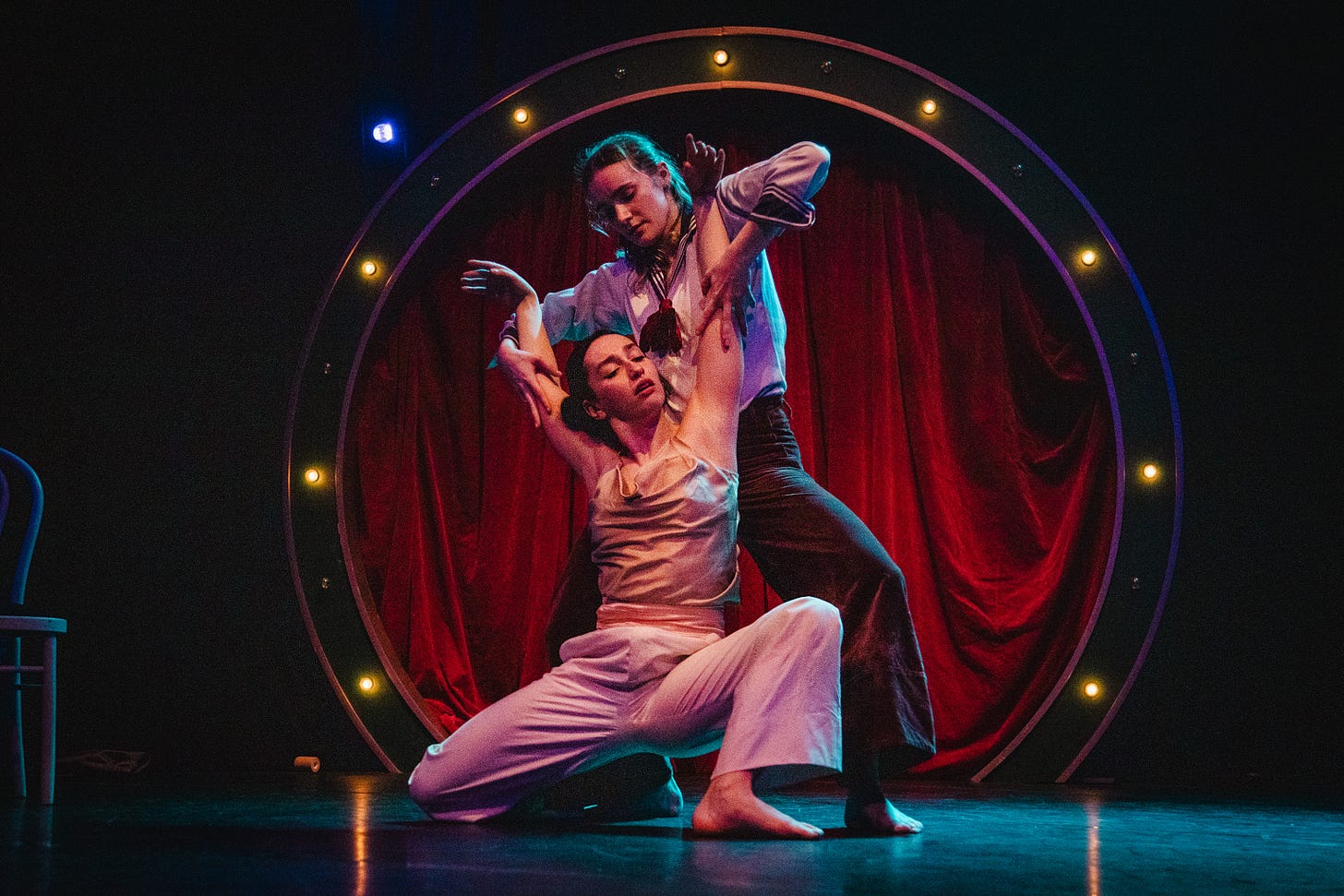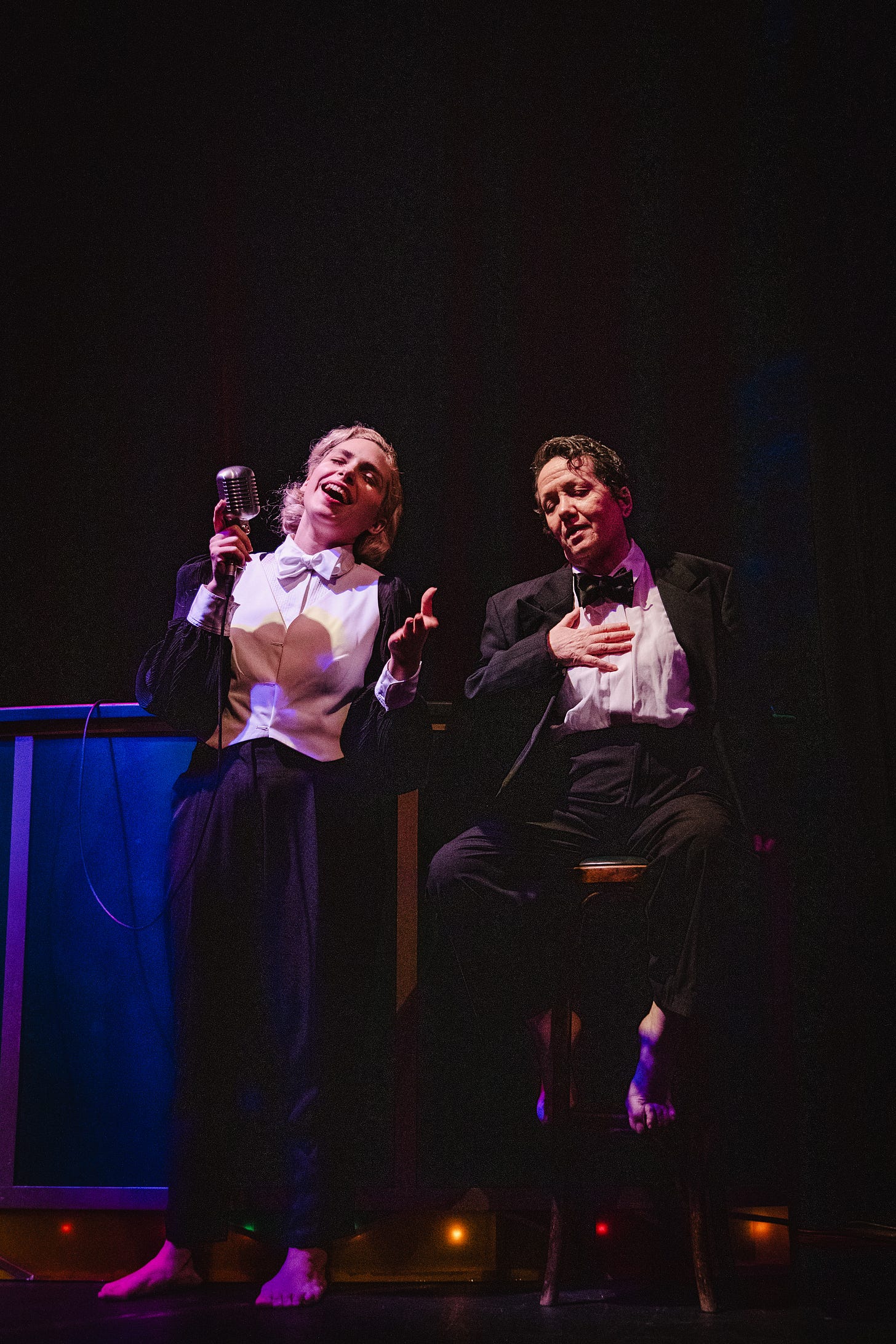Nothing brings me more joy than settling into a sold-out auditorium, bustling with excitement for the collective journey that is to come. As I take my seat in Northern Stage’s studio theatre, the compact space feels more spacious than usual, with draping lights extending out above the auditorium, and seats spilling onto the stage. The Monocle by Rendez-Vous Dance is inspired by the Parisian club of the same name, which in the 1920s and 30s played host to a secretive yet thriving community of lesbians; a safe space for women to drink, dance, and show affection without judgment.
We are first introduced to the captivating Lulu de Montparnasse (Alyssa Lisle), who gradually uncovers the dusty bar and tinted windows of the club. An archway draped with deep red curtains reveals Imogen Banks, our soulful singer for the evening, whose perfect pin curls and rich, expressive voice instantly takes us to the jazz age. Alongside her, BSL interpreter Caroline Ryan standing sultry in her tuxedo, is instantly embedded into the show.
As a series of characters enter the space, some with confidence, others with hesitation, we begin to get a feel for each of their personalities and a suggestion of their backstories. Exchanging knowing looks, they gradually build up to a unison dance phrase of sensual extensions, articulated spines, and virtuosic gestures. With a skilful understanding of rhythm and artistry, the group move as one with growing momentum, every movement oozing with feminine strength.
One of the biggest strengths of the show is the cast’s ability to blend challenging choreography that is full of risk and athleticism, with a convincing portrayal of character. Going far beyond the easy-to-fall-into trap of sprinkling abstract movement with a few pedestrian gestures, dramaturg Andrew Gardiner has helped the cast instead to immerse themselves deeply within their characters, bringing dimension, personality, and vibrancy to their diverse portrayals of the women of Le Monocle. Zara Phillips gives a memorable performance as a newcomer to the club, her character timid at first but soon taking the stage in front of her fellow patrons with a delightfully cheeky solo, full of quirky gestures, engaging expressions and a playful lightness that is incredibly refreshing.
Geffré’s choreography feels daring, skilful, and firmly rooted in his signature stylistic language that blends virtuosity with delicate detail. All the flowing lines of ballet pas de deux, with no men needed to do the lifting, the dancers push their bodies to the limits with tilting, arching, tumbling partner work. There are many sensitive moments, hands cradling and caressing, dancing at the edges of eroticism without being lewd.
Alyssa Lisle’s standout performance as the Monocle’s owner exudes pure strength and power, both physically with her sumptuous control and expansive movement, and emotionally, as she holds the safe space both for the characters and the audience. Her role is perhaps the most complex, with a varied emotional journey of light and dark - as a genuinely terrifying threat approaches the Monocle’s doors, we are forced to question whether anywhere is truly safe.
Taking influence from the horror genre, the threat of ‘the outsider’, clad in a menacing all-black, poses a danger to the Monocle that feels very real. They are faceless, but we know who they are – strangers, neighbours, politicians, historical villains, present day bigots. Calling to mind the sickeningly numerous examples of homophobic attacks, the end of Act 1 is a visceral, painful reminder that the whole world is not as accepting as the room we are currently in.
We are not left to stew in our sadness for too long, and the deliciously throaty voice of Imogen Banks returns to provide refreshing and wonderful interval entertainment, once again accompanied by our enchanting BSL interpreter, and the dancers who remain in the space in gentle vignettes.
The second act begins with a rousing solo from our bartender (played with a commanding presence by Ruth Howard) as she prepares drinks for the lucky audience who are seated downstage right, adding to the immersive ‘cabaret’ feel of the show. Driving music accompanies exaggerated gestures that sweep her along, over, under, and all around the bar. As she serves the drinks however, she is met with a wolf whistle and even a pat on the behind from two Monocle members. A reminder that sexual harassment and assault is not only perpetrated by men, but unfortunately takes place between all genders, I was intrigued at first to see how the show would tackle this important but weighty topic. However, the scene continued into a tragicomedy depiction of a fencing match: fighting for the barmaid’s affections, the increasingly raucous “en garde”s are accompanied by screaming and cackling from the other Monocle patrons, which eventually descends into sobbing, before morphing into a trancelike state. Perhaps touching on themes of macho-ism, violence, and mob mentality, although thought-provoking, this section of the work could use further refinement to make its message clearer.
Le Monocle closed in the late 30s due to the Nazi occupation of Paris, and unfortunately our Monocle meets the same unhappy end. The devastating violation of the safe space leads to a palpable sense of loss, while Lulu and our barmaid (Alyssa Lisle and Ruth Howard) perform a final, beautiful yet heart-wrenching duet. Echoing earlier, happier moments, this time full of tenderness and care as they stretch and curl around each other. Taking weight, falling and catching, the pair find mutual support and comfort. The Monocle isn’t just a place for sexual liberation and exploration, it’s also a place for love, care, and connection; the importance of these safe spaces for the LGBTQIA+ community cannot be clearer.
Through its careful portrayal of this historical story, The Monocle poses many valuable questions. How do we create safe spaces? Where do we draw the line between inclusion and exclusion? Are safe spaces ever truly safe for all? These ideas are as pertinent now as they were in 1930, and the queer community is still facing many of the same struggles. By creating this work, Rendez-Vous Dance has opened discussion and encouraged its audiences to consider answers to these questions. This is the most important role of art, and when it is done with such flair, it is nothing short of breathtaking.
Find out more about The Monocle, including future tour dates here: THE MONOCLE | Rendez-Vous dance
I also encourage you to read:
Why The Monocle? Why Me? Why Now? (rendez-vousdance.com)
Image credits - Rhiannon Banks







Great review! Really gives a sense of the show.
This is great, insightful, sensitive and informative writing Pagan. It makes me want to go to see the show and engage with the production. Dave S.